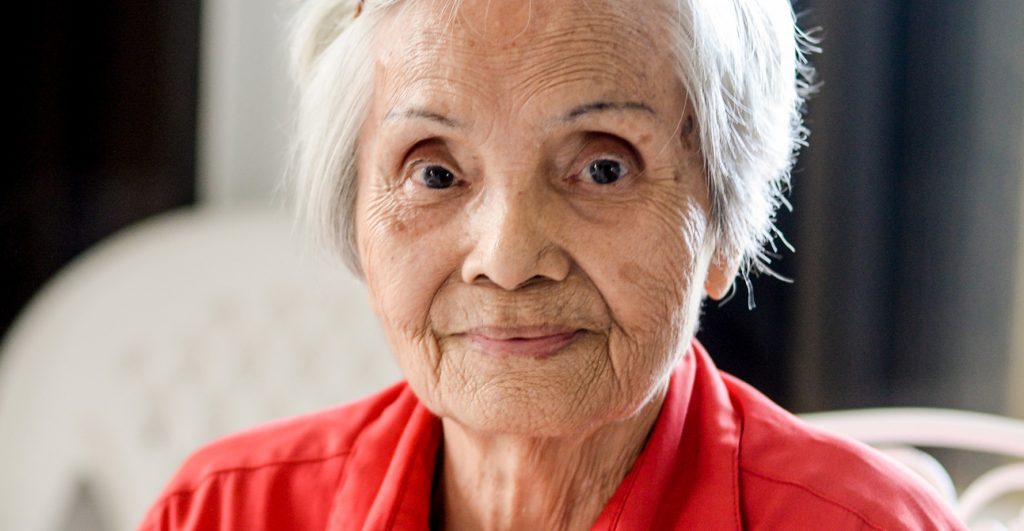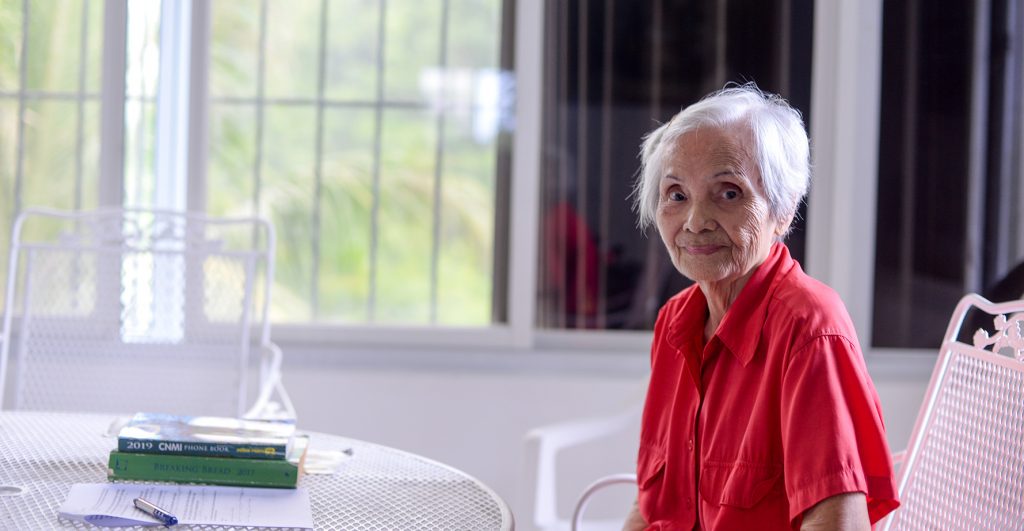YEH-YEH
O land of mine: Saipan and its culture of respect

Marie Castro’s Chamorro upbringing was centered around respect––respect for the land, respect for their family and respect for the community. (LINDSAY NASH)
The Yeh-Yeh series shares rich stories and oral traditions of Saipan. The name is inspired by Refaluwasch elder Lino Olapai’s childhood memory of being told to say “yehyeh” as the elders told stories. Once it was quiet, the elders knew the children were asleep.
If I ever leave this place
One day I will return
Marie Castro’s life is an echo of the Northern Mariana Islands’ anthem, “Gi Talo Gi Halom Tasi.”
Castro, formerly Sister Maria Soledad Castro of the Mercedarian Missionaries of Berriz, spent 50 years of her life in the United States. Now returned, she understands she carried her Chamorro culture with her through it all.
At age 87, Castro has a warm and soft presence as she shares her life and stories—and she has many to tell. Outside her kitchen window, the rain comes down hard in an afternoon shower and a coconut tree waves in the wind.
“It is our tree of life,” she says, nodding toward the tall palm, as ubiquitous on Saipan as the blue-collared kingfishers who twitter atop them.
“We used every part of the coconut,” Castro said. “The leaves for roofing. The white bones of the leaf we used to make a broom. The flower of the coconut to extract tuba for vinegar.” That’s in addition to the oil with its countless uses and the milk so often used in her native Chamorro cooking with taro, yam, and saibuk, a Chamorro specialty with breadfruit.
“We always depended on nature,” Castro said.
Her Chamorro upbringing was centered around respect—respect for the land, respect for their family, respect for the community.
She remembers the old culture of dating, where the boys would stand in the back of the church to watch the girls, choosing who they would court. She also remembered that her father made her chaperone her older sister, who cleverly found a way to skip choir practice to meet her boyfriend.
She remembers the traditional Catholic wake, where family and friends would hold vigils overnight with simple snacks like crackers and coffee as they played cards quietly to pass the time until the next day, when they would accompany the body to Mass and then the burial site.

Marie Castro has spearheaded an effort to create a local memorial for Amelia Earhart. That project, too, is about respect, she said. (LINDSAY NASH)
Castro remembers the simplicity of Sundays with Mass at 5am and then afternoons at home when her mother would read stories from the Bible to her and her siblings.
“Respect is very deeply rooted in our hearts. As little kids, the siblings had to respect their older brothers and sisters. You could not raise your voice to your older brother or sister because it’s a lack of respect.”
It was an important value for Castro both in her early life on Saipan, and later, when she left the island for a college education at Donnelly College in the United States, an opportunity afforded through the Mercedarian Missionaries.
Once in the United States, Castro began to search for a deeper meaning for her life. She loved her religious life, but she felt like something was missing.
As a child who had experienced the terrors of World War II and the invasion of Saipan, Castro felt she owed a debt of gratitude to the American Marines who rescued her family from a cave during the war. She wanted to repay them with service.
This led to a career of teaching in the Kansas City public schools during a difficult period of American history. She became a teacher during the first years of school integration, bringing together white and Black students for the first time.
Challenges quickly arose, Castro said. When a Black student asked if she preferred the white or the Black students, she realized the problems they faced. She sat down with the Black students and asked them to speak candidly about their feelings. “They said what was really on their minds,” Castro remembers. “After they finished, I said, ‘You know what? I’m neither black or white. I came from very far away—an island in the Pacific. I came here because I care about you. I care about the white kids. And I care about you. We are all one family.’”
Castro lived in the United States for 50 years, returning to Saipan every summer to visit her family. When she retired from teaching, she knew it was time to come home for good. “I had already given my service there,” Castro said. “I knew I could still give service to my people. That’s what made me come back.”
Now she is busy in that service to the island. She has spearheaded a grassroots effort to create a memorial for Amelia Earhart, which supports the theory that the famed pilot was brought to Saipan where she eventually perished. This too is about respect, she said.
“We need to try to preserve the culture that has been handed down to us,” Castro said. “Because respect is everything—for the family, for everything.”
The rain picks up again outside, covering the jungle in a blanket of fog. Castro clutches her heart as she thinks about her return to Saipan, when she heard the anthem play at a women’s gathering.
For I can never leave you
O land of mine.
“Hearing those words made me so emotional,” she said. “I thought, ‘Oh, I am back. I am home.’”
Lindsay Nash is a writer and photographer who lives on Saipan. She is a member of the Marianas Writers’ Movement and is currently writing a novel about 20th century Saipan. Email her at lindsayinsaipan@gmail.com.























